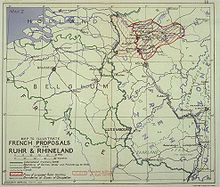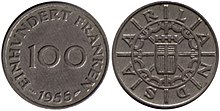Monnet plan

The Monnet Plan was a major modernization program for the French economy in the post-war period. It envisaged a huge expansion of French steel capacity and at the same time a limitation of the competing German steel industry to a maximum of 7.5 million tons per year. Initiator Jean Monnet was the first head of the Commissariat général du Plan (planning office) in France 1946–1950 .
Overview
The "Monnet Plan" concerns the development and expansion of the French iron and steel industry. According to him, steel production in France should be brought to an annual output of 15 million tons by 1953, compared with only 6.2 million tons in 1936.
The enormous expansion of the French steel capacity was carried out partly from Marshall Plan funds and also from tax funds. However, this inflated capacity was only offset by a domestic demand of at most 7 to 8 million tons. The Monnet Plan therefore already anticipated exports of steel, iron and semi-finished products to Germany amounting to 3 million tons per year.
So that the German steel industry built on the Ruhr coal does not become a competitor, the capacity of the German steel industry should remain limited to the originally planned number of maximum 7.5 million tons per year, as the plan provided for. The French steel industry would thus achieve the efficiency of the English. The German steel industry would be eclipsed by the French, while before the war it produced 23.2 million tons, more than the English and French combined.
The Monnet Plan required an additional work force of 1,000,000 men. France expected to keep as long as possible the 740,000 German prisoners of war who were employed as slave labor in mining, agriculture and reconstruction. ( German forced laborers after 1945 )
Foreign Minister Robert Schuman declared in a speech at a trade union meeting in Metz in 1950: "In truth, this plan (the Schuman Plan ) is the continuation of the Monnet Plan " and, "solely to facilitate French steel exports", France "took on this mission" . According to Hans Ritschl : "This speech was not intended for German ears!"
Saar Protectorate
The Saarland was from 1947 to 1956 a protectorate of France with its own government and constitution. The goal was the economic connection to France.
Mining and the associated steel industry were the main employers in the region and shaped the country's economic infrastructure. France took over Saarbergwerke in 1946 and announced the introduction of customs controls between Saarland and the rest of Germany. The "Regie des Mines de la Sarre" took over the administration of the Saar mines in 1947.
The Saar mines produced a third of France's hard coal production in 1946, and still a quarter in 1949. Without the Saar coal, French steel production would have been much lower.
Konrad Adenauer said: “The name 'Protectorate' might still be too good. One could rather speak of a 'colony' - but I won't do that. "
The protectorate ended in January 1957, but economic affiliation with France continued until mid-1959.
International control of the Ruhr area

After the end of World War II, France demanded, based on Jean Monnet's plans, to separate the Ruhr area from Germany; the Soviet Union wanted to place the coal and steel region under international control, the USA demanded special control over the Ruhr area. When the state of North Rhine-Westphalia was founded in 1946, the Ruhr area was largely withdrawn from the influence of France and the Soviet Union.
Despite production restrictions and production bans and despite dismantling , steel production on the Ruhr was resumed. With the plans to found the Federal Republic (1948/1949) and the transfer of state sovereignty to West Germany, France renewed its demand for control of the German coal and steel industry on the Ruhr and thus a restriction of the sovereignty of the West German state. In the appendix to the Ruhr Statute, the Ruhr area, but also some neighboring districts, as well as the industrialized cities of the Bergisches Land and the Düsseldorf area were defined as the Ruhr .
"The Ruhr Statute is the tragic failure of the post-war period [...] The ultimate consequence of the Statute is that the way of life, the standard of living of the German people, no longer depends on German efforts, German industry and German social policy, but on the vote of those interested and competitors of the German economy. "
The agreement (of the International Ruhr Authority) itself was finally ratified by the signatory governments in April 1949, around a month before the Basic Law came into force . The dismantling policy did not end with the Ruhr Statute. On June 13, 1949, Belgian soldiers took action against German workers who tried to use barricades to prevent the dismantling of a hydrogenation plant. It was not until the Petersberg Agreement of November 22, 1949 that the dismantling policy was revised, and at the end of 1950 dismantling was finally stopped in the Federal Republic.
In the debate in the Bundestag in Bonn on November 24, 1949, two days after the Petersberg Agreement, Konrad Adenauer argued: “If I had had a law passed, the dismantling would have reached an unbearable stage after about eight weeks before it was finally passed . "The SPD chairman Kurt Schumacher called Adenauer" Federal Chancellor of the Allies ". The debate ended in turmoil.
See also
Individual evidence
- ↑ Hans Ritschl : The Schuman Plan: The new Ruhr authority , Der Spiegel 1951
- ↑ Stiftung Demokratie Saarland Dialog 15, p.12 (PDF; 1.5 MB)
- ↑ H.-P. Schwarz, Die Ära Adenauer 1949–1957, p. 93.
- ↑ germanhistorydocs
- ↑ library.wisc.edu (PDF; 984 kB)
- ↑ DER SPIEGEL 2/1949
- ↑ DER SPIEGEL 49/1949
Web links
- France, Germany and the Struggle for the War-making Natural Resources of the Rhineland
- The Monnet Plan: France's Struggle for the Rank of Economic Great Power Springer, 1950
- Michael L. Hoffman: The Monnet Plan A solution for France? 1947
- France seeks steel monopoly time, 1947
- French proposal regarding the detachment of German industrial regions September 8, 1945
- Ruhr Delegation of the United States of America, Council of Foreign Ministers American Embassy Moscow March 24, 1947
- Plan The Marshall Plan, 1948–1951 Albrecht Ritschl, Humboldt University - Berlin
- William I. Hitchcock : France Restored: Cold War Diplomacy and the Quest for Leadership in Europe, 1944–1954 Reviewed by Sean Kennedy, University of New Brunswick.
- Challenging the United States: French Foreign Policy 1944–1948 (PDF; 5.4 MB) Good overview, but very large file.
- Information bulletin - Office of the US High Commissioner for Germany Office of Public Affairs, Public Relations Division, APO 757, US Army, January 1952
- Economy - No more guns from the Ruhr!
- Review William I. Hitchcock: France Restored: Cold War Diplomacy and the Quest for Leadership in Europe, 1944-1954. Chapel Hill: University of North Carolina Press, 1998. 291 pp. ISBN 978-0-8078-4747-3
- Andrew Hrycaj: Challenging the United States: French Foreign Policy 1944-1948 (PDF; 5.4 MB)

